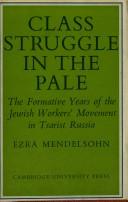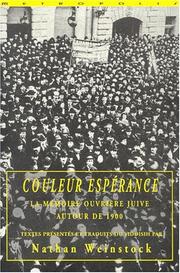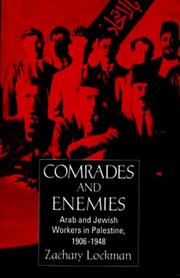| Listing 1 - 8 of 8 |
Sort by
|

ISBN: 0521077303 Year: 1970 Publisher: Cambridge [Eng.] : University Press,
Abstract | Keywords | Export | Availability | Bookmark
 Loading...
Loading...Choose an application
- Reference Manager
- EndNote
- RefWorks (Direct export to RefWorks)
Jewish trade-unions --- Jews --- Working class --- Juifs --- Travailleurs --- Jewish labor unions --- Working class Jews
Book
ISBN: 9782883401174 2883401179 Year: 2001 Publisher: Genève : Metropolis,
Abstract | Keywords | Export | Availability | Bookmark
 Loading...
Loading...Choose an application
- Reference Manager
- EndNote
- RefWorks (Direct export to RefWorks)
Labor movement --- Working class Jews --- Jewish labor unions --- Jews --- Social movements --- Immigrants --- Juifs --- Mouvements sociaux --- Jews. --- History --- History --- Social conditions --- History --- History --- Conditions sociales --- Histoire --- Jewish emigration --- 19th century --- Social history --- Strike

ISBN: 9782883401051 2883401055 9782883401372 Year: 2004 Publisher: Genève Metropolis
Abstract | Keywords | Export | Availability | Bookmark
 Loading...
Loading...Choose an application
- Reference Manager
- EndNote
- RefWorks (Direct export to RefWorks)
jodendom --- sociale geschiedenis --- egodocumenten --- Working class Jews --- Jews --- Litwak, A. --- Levine, Sholem --- Berman, L. --- Bernstein, Leon --- Allgemeyner Idisher arbeyterbund in Lita, Poylen un Rusland --- Lévy, Pierre Gaspard. --- Editions du Carrefour --- Bifur. --- 655.41 <44> EDITIONS DU CARREFOUR --- 050 <09> <44> "19" --- Uitgeverij--algemeen--Frankrijk--EDITIONS DU CARREFOUR --- Tijdschriften. Periodieken. Serials--(werken over)--Geschiedenis van ...--Frankrijk--20e eeuw. Periode 1900-1999 --- 050 <09> <44> "19" Tijdschriften. Periodieken. Serials--(werken over)--Geschiedenis van ...--Frankrijk--20e eeuw. Periode 1900-1999 --- Lévy, Pierre Gaspard. --- 82:655.5 --- 82:655.5 Literatuur en uitgeverij. Literatuur en boekhandel --- Literatuur en uitgeverij. Literatuur en boekhandel --- Book history --- France --- joodse arbeidersbeweging --- Lévy, Pierre Gaspard --- Working class Jews - Europe, Eastern --- Jews - Russia --- Jews - Europe, Eastern
Book
ISBN: 1618115936 1618114352 9781618115935 9781618114358 Year: 2019 Publisher: Boston
Abstract | Keywords | Export | Availability | Bookmark
 Loading...
Loading...Choose an application
- Reference Manager
- EndNote
- RefWorks (Direct export to RefWorks)
Doba-Mera Medvedeva belongs to a vanishingly small group of memoirists who are neither elite nor highly literate, but whose observations from the ground cast a vivid light on a lost world. The book reveals the quarrelsome underside of shtetl life at a time of scarce resources, and describes how Doba-Mera survives two pogroms and two world wars. Around 1905, barely a teenager but already earning a living, she joins Marxist circles and takes part in clandestine activities. Through her eyes we experience the class divisions in shtetl and synagogue, as well as aspects of everyday life such as education, courtship and marriage, housing, food, illness, and the organization of the working life and working conditions in sewing shops.
Jewish communists --- Jews --- BIOGRAPHY & AUTOBIOGRAPHY / Personal Memoirs. --- 1905. --- Jewish courtship and marriage. --- Jewish education. --- Jewish memoirs. --- Jewish women’s education. --- Jewish women’s writing. --- Jews of Russia. --- Jews. --- Marxist circles among Jews. --- Pale of settlement. --- Russia. --- Russian Jews. --- WWI. --- WWII. --- World War 1. --- World War 2. --- World War I. --- World War II. --- World War One. --- World Way Two. --- Yiddish. --- biography. --- family heritage. --- family history. --- memoir. --- noteooks. --- pogrom. --- pogroms. --- shtetl life. --- shtetl. --- working-class Jews. --- Hebrews --- Israelites --- Jewish people --- Jewry --- Judaic people --- Judaists --- Ethnology --- Religious adherents --- Semites --- Judaism --- Communism --- Communists --- Medvedeva, Doba-Mera, --- Khotsimski rai︠o︡n (Belarus) --- Saint Petersburg (Russia) --- Gurevich, Doba-Mera, --- Medvedeva, Miriam, --- Gurevich, Miriam, --- Khotimskiĭ raĭon (Belarus) --- Хоцімскі раён (Belarus) --- Хотимский район (Belarus)

ISBN: 0520204190 0520917499 0585078998 9780520917491 1587292416 9781587292415 9780520202597 0520202597 9780520204195 9780585078991 0520202597 0877452458 9780877452454 Year: 1990 Publisher: Iowa City, Iowa University of Iowa Press
Abstract | Keywords | Export | Availability | Bookmark
 Loading...
Loading...Choose an application
- Reference Manager
- EndNote
- RefWorks (Direct export to RefWorks)
In Comrades and Enemies Zachary Lockman explores the mutually formative interactions between the Arab and Jewish working classes, labor movements, and worker-oriented political parties in Palestine just before and during the period of British colonial rule. Unlike most of the historical and sociological literature on Palestine in this period, Comrades and Enemies avoids treating the Arab and Jewish communities as if they developed independently of each other. Instead of focusing on politics, diplomacy, or military history, Lockman draws on detailed archival research in both Arabic and Hebrew, and on interviews with activists, to delve into the country's social, economic, and cultural history, showing how Arab and Jewish societies in Palestine helped to shape each other in significant ways.Comrades and Enemies presents a narrative of Arab-Jewish relations in Palestine that extends and complicates the conventional story of primordial identities, total separation, and unremitting conflict while going beyond both Zionist and Palestinian nationalist mythologies and paradigms of interpretation.
Working class
---
Labor Zionism
---
Working class Jews
---
Palestinian Arabs
---
Labor movement
---
Railroads
---
Business & Economics
---
Labor & Workers' Economics
---
History
---
Employment
---
Employees
---
Labor and laboring classes
---
Arab Palestinians
---
Arabs
---
Arabs in Palestine
---
Palestinians
---
Jewish working class
---
Commons (Social order)
---
Laboring class
---
Labouring class
---
Working classes
---
Iron horses (Railroads)
---
Lines, Railroad
---
Rail industry
---
Rail lines
---
Rail transportation
---
Railroad industry
---
Railroad lines
---
Railroad transportation
---
Railway industry
---
Railways
---
<
Book
ISBN: 0813551684 0813552257 1283864525 9780813552255 9780813551685 Year: 2012 Publisher: New Brunswick, NJ
Abstract | Keywords | Export | Availability | Bookmark
 Loading...
Loading...Choose an application
- Reference Manager
- EndNote
- RefWorks (Direct export to RefWorks)
The Jewish Labor Bund was one of the major political forces in early twentieth-century Eastern Europe. But the decades after the Second World War were years of enormous difficulty for Bundists. Like millions of other European Jews, they faced the challenge of resurrecting their lives, so gravely disrupted by the Holocaust. Not only had the organization lost many members, but its adherents were also scattered across many continents. In this book, David Slucki charts the efforts of the surviving remnants of the movement to salvage something from the wreckage. Covering both the Bundists who remained in communist Eastern Europe and those who emigrated to the United States, France, Australia, and Israel, the book explores the common challenges they faced-building transnational networks of friends, family, and fellow Holocaust survivors, while rebuilding a once-local movement under a global umbrella. This is a story of resilience and passion-passion for an idea that only barely survived Auschwitz.
HISTORY --- Europe / Eastern --- Working class Jews --- Jews --- Jewish socialists --- Labor movement --- Business & Economics --- Labor & Workers' Economics --- History --- Politics and government --- Allgemeyner Idisher arbayṭerbund in Liṭa, Poylen un Rusland --- Influence. --- Labor and laboring classes --- Socialists, Jewish --- Hebrews --- Israelites --- Jewish people --- Jewry --- Judaic people --- Judaists --- Jewish working class --- Algemeyner Yidisher arbeṭer bund in Liṭe, Poyln un Rusland --- Algemeyner Yidisher arbeṭerbund in Liṭa, Poylen un Rusland --- Allgemeiner Jüdischer Arbeiterbund in Litauen, Polen und Russland --- Berit ha-poʻalim ha-Yehudit ha-kelalit be-Rusyah, Liṭa u-Polin --- Bund --- "Bund" ha-Rusi --- General Jewish Labor Bund --- General Jewish Workers' Bund --- "General Jewish Workers' League in Lithuania, Poland, and Russia (Bund)" --- Jewish Bund --- Jewish Labor Bund --- Jewish Workers' Bund --- Jüdischer Arbeiter-Bund Russlands --- Ogólno-Żydowski Związek Robotniczy na Litwie, w Polsce i Rosji --- Ogólny Żydowski Związek Robotniczy "Bund" na Litwie, w Polsce i w Rosji --- Powszechny Żydowski Związek Robotniczy w Polsce, Litwie i Rosji --- Rossiĭskai︠a︡ sot︠s︡ial-demokraticheskai︠a︡ rabochai︠a︡ partii︠a︡. --- Russian Bund --- Tenuʻat ha-Bund be-Polin --- Vseobshchiĭ evreĭskiĭ rabochiĭ soi︠u︡z v Litve, Polʹshe i Rossii --- Vseobshchiĭ evreiskiĭ soi︠u︡z v Litve, Polśhe i Rossii --- אללגעמײנער אידישער ארבײטערבונד אין ליטא, פױלען און רוסלאנד --- אלגעמיינער אידישער ארבייטערבונד אין ליטא, פוילען און רוסלאנד --- אלגעמיינער אידישער ארבייטערבונד אין ליטא, פוילן און רוסלאנד --- אלגעמיינער יידישער ארבעטער פארבאנד ״בונד״ פון ליטא, פולין, און רוסלאנד --- בונד --- בונד הרוסי --- Unione generale degli operai ebrei di Russia, Polonia e Lituania --- Social movements --- Socialists --- Ethnology --- Religious adherents --- Semites --- Judaism --- Ogólny Żydowski Związek Robotniczy "Bund" w Polsce --- E-books --- Allgemeyner Idisher arbayterbund in Lita, Poylen un Rusland
Book
ISBN: 9004361766 9004361758 Year: 2018 Publisher: Leiden ; Boston : Brill,
Abstract | Keywords | Export | Availability | Bookmark
 Loading...
Loading...Choose an application
- Reference Manager
- EndNote
- RefWorks (Direct export to RefWorks)
Bundist Legacy after the Second World War offers an account on post-war Bund, the most important Jewish political party in East Europe before the outbreak of the Second World War. This subject area has attracted more attention in the last few years, when a new generation of scholars is trying to assess the “transformation” of memory and the political, cultural and pedagogical role played by the last members of Bund. This volume aims to create a new “Bund” (union) after the end of historical Bund, and help to answer the question, “What is to be done after the birth of Israel?” The volume is one of the first attempts to answer this crucial existential and political question.
Working class Jews --- Jews --- Jewish socialists --- Labor movement --- Holocaust, Jewish (1939-1945) --- Labor and laboring classes --- Social movements --- Socialists, Jewish --- Socialists --- Hebrews --- Israelites --- Jewish people --- Jewry --- Judaic people --- Judaists --- Ethnology --- Religious adherents --- Semites --- Judaism --- Jewish working class --- History --- Politics and government --- Influence. --- Allgemeyner Idisher arbayṭerbund in Liṭa, Poylen un Rusland --- Algemeyner Yidisher arbeṭer bund in Liṭe, Poyln un Rusland --- Algemeyner Yidisher arbeṭerbund in Liṭa, Poylen un Rusland --- Allgemeiner Jüdischer Arbeiterbund in Litauen, Polen und Russland --- Berit ha-poʻalim ha-Yehudit ha-kelalit be-Rusyah, Liṭa u-Polin --- Bund --- "Bund" ha-Rusi --- General Jewish Labor Bund --- General Jewish Workers' Bund --- "General Jewish Workers' League in Lithuania, Poland, and Russia (Bund)" --- Jewish Bund --- Jewish Labor Bund --- Jewish Workers' Bund --- Jüdischer Arbeiter-Bund Russlands --- Ogólno-Żydowski Związek Robotniczy na Litwie, w Polsce i Rosji --- Ogólny Żydowski Związek Robotniczy "Bund" na Litwie, w Polsce i w Rosji --- Powszechny Żydowski Związek Robotniczy w Polsce, Litwie i Rosji --- Rossiĭskai︠a︡ sot︠s︡ial-demokraticheskai︠a︡ rabochai︠a︡ partii︠a︡. --- Russian Bund --- Tenuʻat ha-Bund be-Polin --- Vseobshchiĭ evreĭskiĭ rabochiĭ soi︠u︡z v Litve, Polʹshe i Rossii --- Vseobshchiĭ evreiskiĭ soi︠u︡z v Litve, Polśhe i Rossii --- אללגעמײנער אידישער ארבײטערבונד אין ליטא, פױלען און רוסלאנד --- אלגעמיינער אידישער ארבייטערבונד אין ליטא, פוילען און רוסלאנד --- אלגעמיינער אידישער ארבייטערבונד אין ליטא, פוילן און רוסלאנד --- אלגעמיינער יידישער ארבעטער פארבאנד ״בונד״ פון ליטא, פולין, און רוסלאנד --- בונד --- בונד הרוסי --- Unione generale degli operai ebrei di Russia, Polonia e Lituania --- Ogólny Żydowski Związek Robotniczy "Bund" w Polsce
Book
ISBN: 0814763464 9780814763452 0814763456 9780814763469 081475743X 0814757448 9780814757437 9780814757444 Year: 2012 Publisher: New York, NY
Abstract | Keywords | Export | Availability | Bookmark
 Loading...
Loading...Choose an application
- Reference Manager
- EndNote
- RefWorks (Direct export to RefWorks)
Jewish Radicals explores the intertwined histories of Jews and the American Left through a rich variety of primary documents. Written in English and Yiddish, these documents reflect the entire spectrum of radical opinion, from anarchism to social democracy, Communism to socialist-Zionism. Rank-and-file activists, organizational leaders, intellectuals, and commentators, from within the Jewish community and beyond, all have their say. Their stories crisscross the Atlantic, spanning from the United States to Europe and British-ruled Palestine.The documents illuminate in fascinating detail the efforts of large numbers of Jews to refashion themselves as they confronted major problems of the twentieth century: poverty, anti-semitism, the meaning of American national identity, war, and totalitarianism. In this comprehensive sourcebook, the story of Jewish radicals over seven decades is told for the first time in their own words.
Labor movement --- Working class Jews --- Jews, East European --- Immigrants --- Jewish socialists --- Labor and laboring classes --- Social movements --- Jewish working class --- Jews --- East European Jews --- Emigrants --- Foreign-born population --- Foreign population --- Foreigners --- Migrants --- Persons --- Aliens --- Socialists, Jewish --- Socialists --- History --- Political activity --- New York (N.Y.) --- New York (City) --- Ni︠u︡ Ĭork (N.Y.) --- Novi Jork (N.Y.) --- Nova Iorque (N.Y.) --- Nyu-Yorḳ (N.Y.) --- Nueva York (N.Y.) --- Nu Yorḳ (N.Y.) --- Nyuyok (N.Y.) --- Nuyorḳ (N.Y.) --- New York City (N.Y.) --- Niyū Yūrk (N.Y.) --- Niyūyūrk (N.Y.) --- Niu-yüeh (N.Y.) --- Nowy Jork (N.Y.) --- City of New York (N.Y.) --- New York Stad (N.Y.) --- نيويورك (N.Y.) --- Táva Nueva York (N.Y.) --- Nyu-York Şähäri (N.Y.) --- Нью-Йорк (N.Y.) --- Горад Нью-Ёрк (N.Y.) --- Horad Nʹi︠u︡-I︠O︡rk (N.Y.) --- Нью-Ёрк (N.Y.) --- Ню Йорк (N.Y.) --- Nova York (N.Y.) --- Çĕнĕ Йорк (N.Y.) --- Śĕnĕ Ĭork (N.Y.) --- Dakbayan sa New York (N.Y.) --- Dinas Efrog Newydd (N.Y.) --- Efrog Newydd (N.Y.) --- Nei Yarrick Schtadt (N.Y.) --- Nei Yarrick (N.Y.) --- Νέα Υόρκη (N.Y.) --- Nea Yorkē (N.Y.) --- Ciudad de Nueva York (N.Y.) --- Novjorko (N.Y.) --- Nouvelle York (N.Y.) --- Nua-Eabhrac (N.Y.) --- Cathair Nua-Eabhrac (N.Y.) --- Caayr York Noa (N.Y.) --- York Noa (N.Y.) --- Eabhraig Nuadh (N.Y.) --- Baile Eabhraig Nuadh (N.Y.) --- Нью Йорк балhсн (N.Y.) --- Nʹi︠u︡ Ĭork balḣsn (N.Y.) --- Шин Йорк (N.Y.) --- Shin Ĭork (N.Y.) --- 뉴욕 (N.Y.) --- Lungsod ng New York (N.Y.) --- Tchiaq York Iniqpak (N.Y.) --- Tchiaq York (N.Y.) --- New York-borg (N.Y.) --- Nuova York (N.Y.) --- ניו יורק (N.Y.) --- New York Lakanbalen (N.Y.) --- Lakanabalen ning New York (N.Y.) --- Evrek Nowydh (N.Y.) --- Nouyòk (N.Y.) --- Bajarê New Yorkê (N.Y.) --- New Yorkê (N.Y.) --- Mueva York (N.Y.) --- Sivdad de Mueva York (N.Y.) --- סיבֿדאד די מואיבֿה יורק (N.Y.) --- Sivdad de Muevah Yorḳ (N.Y.) --- מואיבֿה יורק (N.Y.) --- Muevah Yorḳ (N.Y.) --- Novum Eboracum (N.Y.) --- Neo-Eboracum (N.Y.) --- Civitas Novi Eboraci (N.Y.) --- Ņujorka (N.Y.) --- Niujorkas (N.Y.) --- Niujorko miestas (N.Y.) --- Niuiork (N.Y.) --- Њујорк (N.Y.) --- Njujork (N.Y.) --- Bandar Raya New York (N.Y.) --- Bandaraya New York (N.Y.) --- Nuoba Iorque (N.Y.) --- Нью-Йорк хот (N.Y.) --- Nʹi︠u︡-Ĭork khot (N.Y.) --- Āltepētl Yancuīc York (N.Y.) --- Niej-York (N.Y.) --- ニューヨーク (N.Y.) --- Nyū Yōku (N.Y.) --- ニューヨーク市 (N.Y.) --- Nyū Yōku-shi (N.Y.) --- NYC (N.Y.) --- N.Y.C. (N.Y.) --- Ethnic relations --- E-books
| Listing 1 - 8 of 8 |
Sort by
|

 Search
Search Feedback
Feedback About UniCat
About UniCat  Help
Help News
News